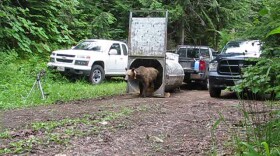Grizzly bears in the lower 48 will remain protected as “threatened” under the Endangered Species Act, federal officials announced Wednesday.
The decision from the U.S. Fish and Wildlife Service came after Montana, Wyoming, and Idaho argued that grizzlies had recovered and should be managed by the states rather than the federal government, especially in and around Yellowstone and Glacier national parks. Those regions are each home to about 1,000 bears and that management change could eventually include a hunting season.
Instead of delisting grizzly populations one by one as they recover, the U.S. Fish and Wildlife Service said they will consider all grizzlies outside of Alaska that exist in and between six federally-designated recovery zones in the Northern Rockies as part of one, bigger bear population. The agency said that bigger population still needs protections because it faces threats from human-caused mortality and habitat loss.
The U.S. Fish and Wildlife Service had previously tried twice to remove protection for Yellowstone-area bears specifically, but those attempts were overturned in court.
Conservation groups widely lauded the Biden Administration’s move to retain federal protections for grizzlies. Andrea Zaccardi is with the Center for Biological Diversity.
“We’re relieved that the Fish and Wildlife Service finally followed the science and determined that grizzly bear still need federal protection,” said Zaccardi.
State officials, though, criticized the decision. Here’s governor Greg Gianforte in a recorded statement.
“We are deeply disappointed with the Biden Administration and its complete defiance of the science and the law,” Gianforte said.
Gianforte said he’ll work with the Trump Administration to find a new path forward. Congress could also remove protections for grizzlies, though previous attempts to do so through legislation have failed
The federal government’s announcement also includes a new rule that will allow more flexibility to managing grizzlies, especially problem bears outside of areas crucial for bear recovery. The new rule will feature a 60-day public comment period and four public meetings, including one in Missoula on January 28.
-
In a reversal, federal wildlife managers won't issue a national wolf recovery plan; Hunters unscathed after grizzly bear charge.
-
Three hunters in two separate incidents recently came face to face with grizzly bears near Big Sky. Montana Fish, Wildlife and Parks says there were no injuries, but advises recreationists to be wary.
-
Local and tribal governments will now get an advanced notice before state wildlife officials relocate bears into their area, under a new state law that went into effect this week.
-
A federal court ruled Wednesday the U.S. Forest Service broke the law when it expanded livestock grazing in grizzly bear habitat north of Yellowstone National Park.
-
The Congressional Western Caucus met with federal and state officials at a conference in the Flathead this week. They called for more aggressive natural resource management, more state control and less federal bureaucracy.








